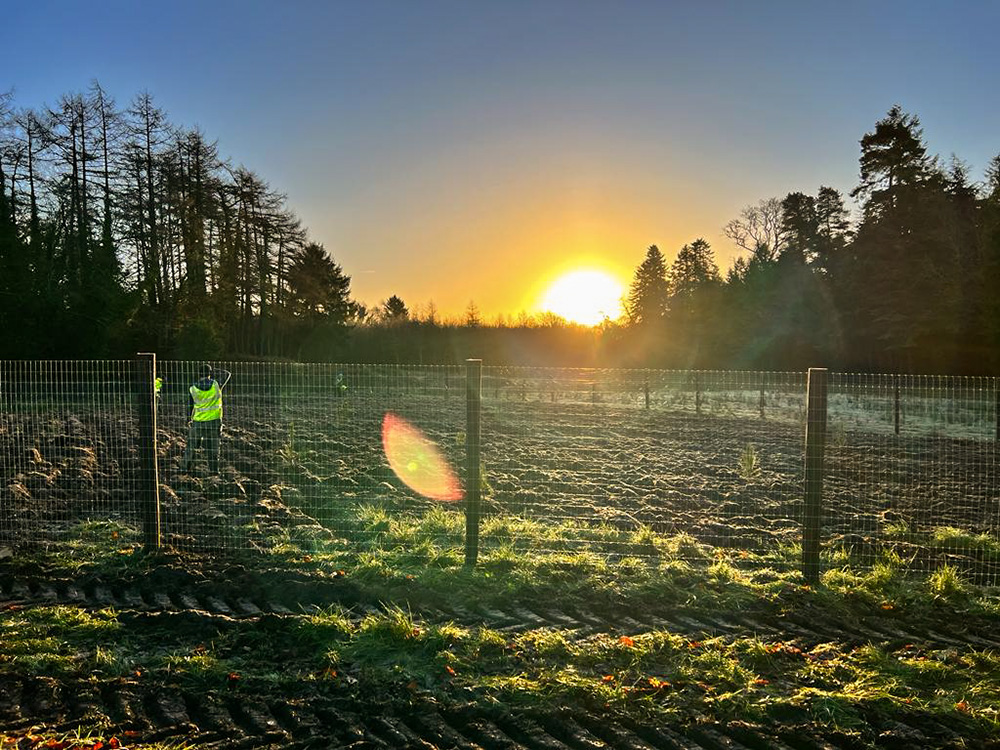
Sunrise on the grounds of Glenstal Abbey in County Limerick, Ireland (Courtesy of 100 Million Trees Project)
There is a line in Psalm 107 about turning a barren wilderness into an oasis. It sprang to mind as Dr. David Mulcahy recounted how he and his brother Richard, along with volunteers from the 100 Million Trees Project, transformed a small, neglected area in a Dublin industrial estate into a mini forest just ahead of Easter.
The quarter of an acre site belongs to Ireland's Industrial Development Agency. "It was just an empty space with nothing growing on it. We have been able to transform it into a small area of biodiversity," Mulcahy, a top cardiologist in Dublin, told Earthbeat.
First, they had to dig up the land, then they brought in tons of topsoil, and last they planted 2,500 native Irish trees using the Miyawaki method of accelerated growth, creating a rapid carbon sink and leading to increased biodiversity.
"It was the perfect place to do this," Mulcahy explained.
Unlike most of the other 400 small sites the 100 Million Trees Project has been offered so far this year, it was not part of a field on a farm but rather was unused land in an urban setting.
Advertisement
The Industrial Development Agency has sites in industrial estates all over Ireland. The Mulcahy brothers, who founded the trees project, hope that this might be the first of many sites that the state agency will pass on to them over the next decade. The trees project has a target of planting 100 million native Irish trees over a period of 10 years.
In order to achieve that target, they need to plant an average of 1 million trees per year in their effort to reverse the immense environmental damage caused by the reduction of forests in Ireland and worldwide, which in turn has contributed to a loss of biodiversity.
"The reality is we are facing a catastrophe; we have to do something about the environment. Planting trees is the most effective and the quickest way of extracting carbon from the atmosphere," Richard Mulcahy stated.
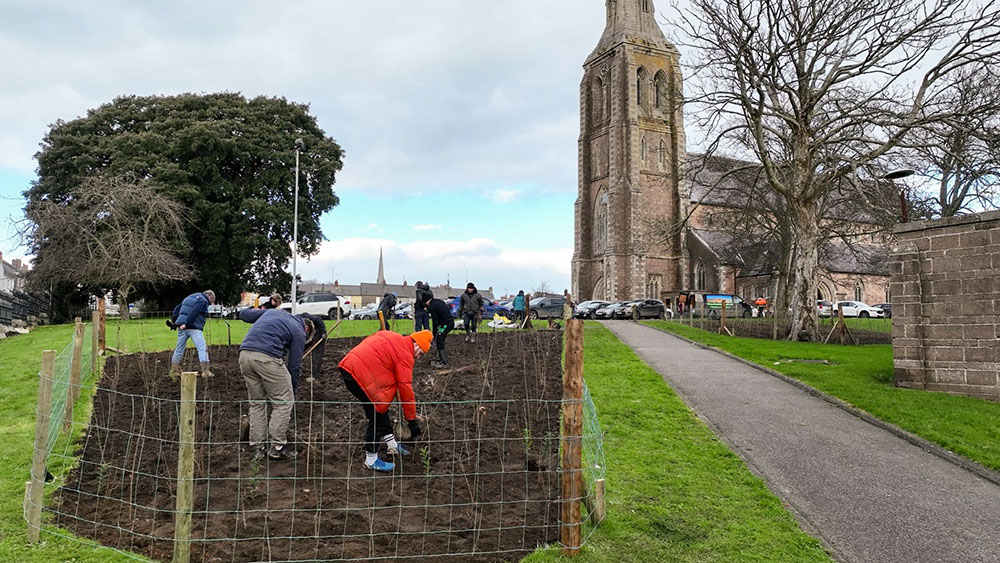
One of the mini forests at Bride Street Church in County Wexford, Ireland, where 1,000 native Irish trees were planted across two mini forests (Courtesy of 100 Million Trees Project)
The businessman has adopted the Japanese botanist and natural forest expert Akira Miyawaki's concept of planting trees very close together. "Instead of planting 1,000 trees an acre, you are planting 10,000 trees in an acre. The trees are on top of each other and because they can't grow out, they grow up, creating an area of biodiversity far quicker," Richard Mulcahy said.
This is the second year of the project, which got off to a flying start in January when the Benedictine monks in Glenstal Abbey invited the Mulcahys and their team of volunteers on the eve of the Epiphany to plant 2,500 saplings on a quarter of an acre site at their County Limerick monastery.
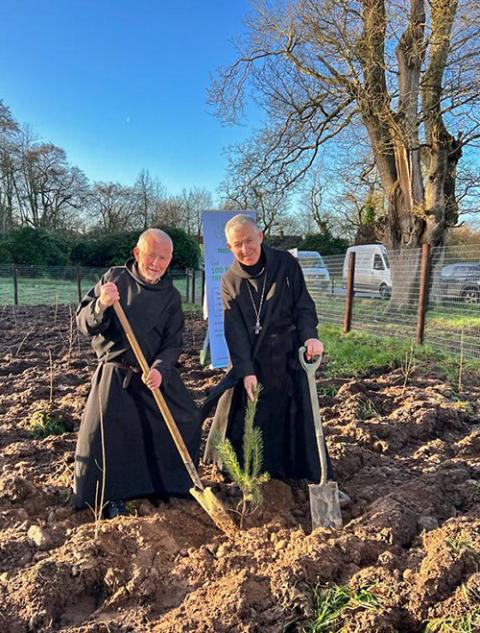
Benedictine Fr. Anthony Keane and Abbot Brendan Coffey plant saplings at Glenstal Abbey in County Limerick, Ireland. (Courtesy of 100 Million Trees Project)
Welcoming the initiative, Abbot Brendan Coffey explained, "At Glenstal Abbey, we believe in the sacred responsibility of stewardship for the Earth. The 100 Million Trees Project aligns perfectly with our values, and we are honored to contribute to this noble cause by providing both our land and the hands to plant these trees. This initiative not only enriches our local environment but contributes to the greater ecological and indeed spiritual well-being of our nation."
This is the kind of commitment needed if Ireland is to live up to its pledges on climate change. According to the Climate Change Performance Index 2024 rankings, Ireland dropped six places to 43rd out of 59 countries. Though Ireland has a legally binding five-year carbon budget and government-set sectoral emissions ceilings, the index shows that implementation is falling far short of meeting these budgets and ceilings.
The planting in Glenstal was part of the 100 Million Trees Project's winter program, which began last November. By the start of April, up to 250,000 saplings of native tree varieties had been planted at more than 100 sites around the country. The planting will recommence this November.
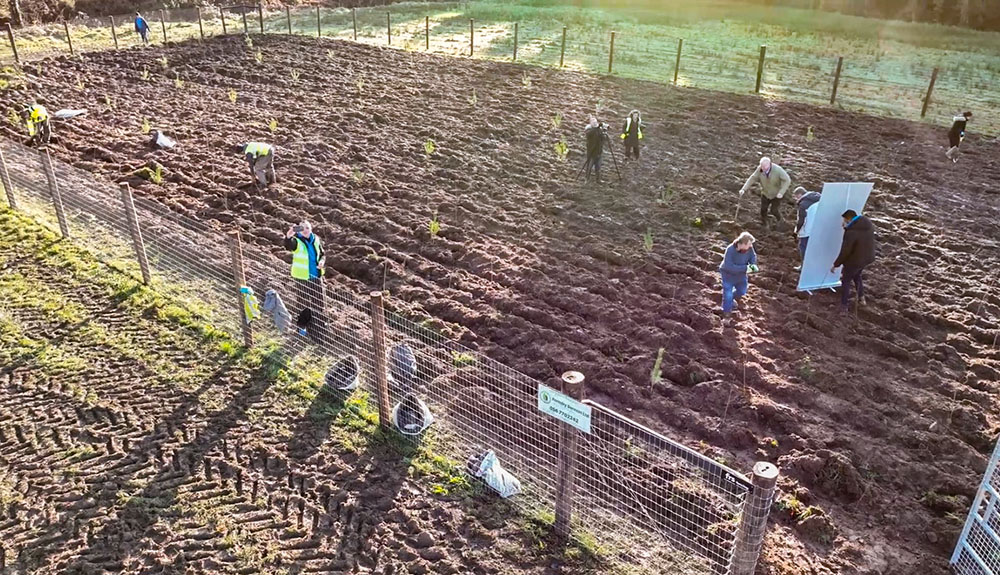
A team of volunteers from the 100 Million Trees Project, including co-founders David Mulcahy and Richard Mulcahy, plant the quarter of an acre site at Glenstal Abbey in County Limerick, Ireland. (Courtesy of 100 Million Trees Project)
The project has already planted trees at sites in nine counties across Ireland, in places such as Fairyhouse Racecourse in County Meath, Limerick Racecourse in County Limerick, and Kiltegan village in County Wicklow. Because the amount of land the project asks donors to give is small, the Mulcahys highlight that these mini forests can be planted on portions of dormant council land, corporate sites and farmland.
The abbey is a place of prayer, work, education and hospitality set on 500 acres of prime farmland, forest, lakes and streams in southwest Ireland. Benedictine Fr. Anthony Keane is an expert on Glenstal's forests, which contain some of the oldest trees in Ireland, including the remains of the country's primitive oak forest. These are located along the edge of Glenstal's front avenue.
It was former abbot Fr. Mark Patrick Hederman who introduced the Mulcahy brothers and their project to Glenstal.
A wide diversity of native trees was planted by the 100 Million Trees' volunteers in January in Glenstal, including apple, cherry, oak, sloe, pine, rowan, spindle and holly.
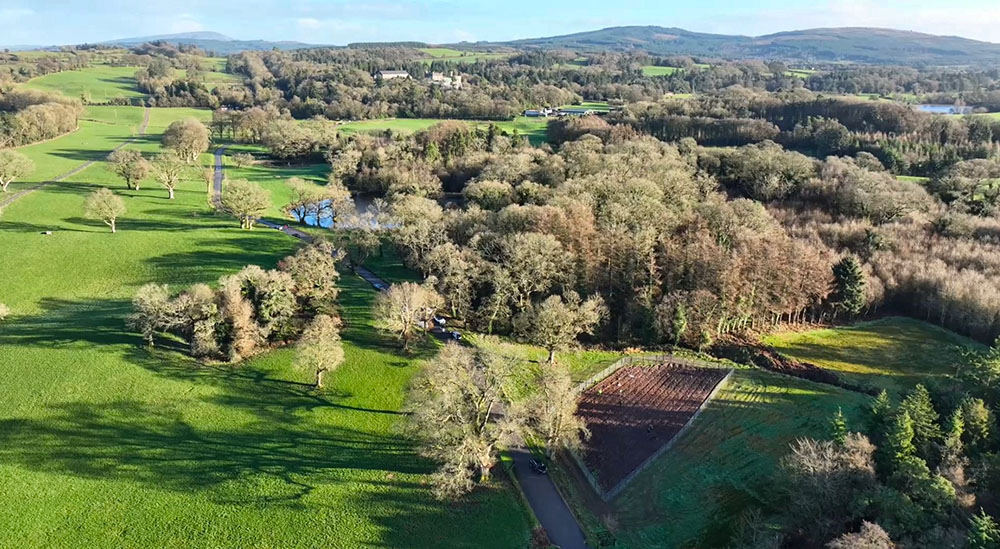
An aerial view of the grounds of Glenstal Abbey in County Limerick, Ireland, where a quarter of an acre site donated to the 100 Million Trees Project can be seen. The project planted 2,500 native Irish saplings at the site on Jan. 5. (Courtesy of 100 Million Trees Project)
These species are found within the natural woodland of Glenstal, according to Keane, who since 1984 has dedicated himself to replenishing the forests. There were "big gaps in the oak wood" for various reasons, including the estate's previous incarnation as a deer park for hunting in the 19th century, before the monks' arrival in 1927.
"It is glorious in summer when the leaves come out and it is like being in an ocean — you get all the waves of the sea in the upper canopy waving in the wind," Keane said.
"I do worry about the forest sometimes; I am concerned about the future. I try to intervene beneficially. But I realize that the story is much bigger than I am, and it is not really my doing — it is way beyond me. I feel close to a great divine manifestation which is the symphony of the forest."
When I visited, he was planting plum trees, whose fruit will, in time, offer a source of nourishment to the forests' natural inhabitants as well as visitors taking a stroll.
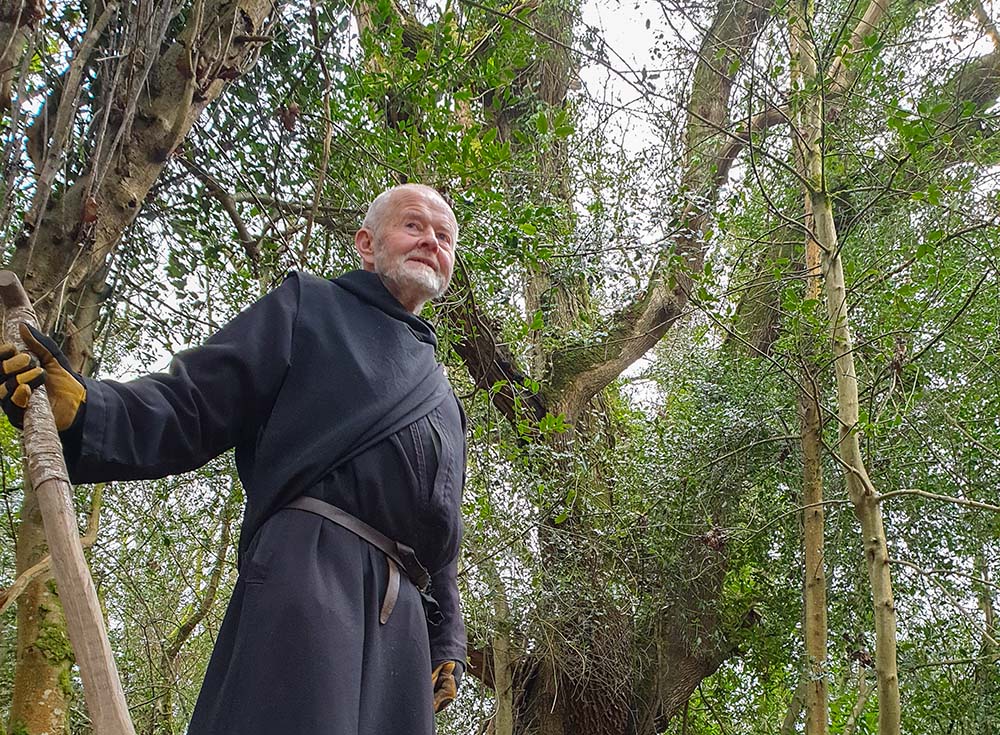
Benedictine Fr. Anthony Keane, Glenstal Abbey's forester, who has been replenishing the forests on the monastery's grounds since 1984 (Sarah Mac Donald)
"We are slipping them in here and there so that wayfarers can find something sweet to eat. In a year they will produce a little fruit, and by their third year they will produce abundant fruit," Keane explained.
Currently there are 50-60 varieties of trees on the grounds of Glenstal, not all of them native Irish trees.
"We believe in biodiversity in an ecologically functional way. The Barringtons [who owned the estate before it came into the hands of the Benedictines] introduced the great botanical wonders of the world — namely the conifers of North America as well as conifers from Japan. They also introduced plants like pheasant berry to feed their game. Our singing birds are feasting on them and spreading them even further," said Keane.
Hederman heavily emphasized how helpful the project volunteers are and how easy it is for participants who are providing land, saying, "They specify what they need, and they send you a film to show you what work should be done in preparation such as fencing off the site to protect the saplings from deer and other predators."
He was so impressed with how the project operated that he recommended it to the abbot primate of the Benedictines, Fr. Gregory Polan, who happened to be staying in Glenstal at the time of the plantation. As a result, Polan is to recommend the project to Benedictines worldwide who have a quarter of an acre to spare as "a very good way of doing what the Lord, the pope and everybody on the planet wants — to try and get trees growing," Hederman said.
David Mulcahy explained that the basic concept of the project is "trees by the people, for the people. People will determine if it is successful or not. We pay for the trees and we also pay for the professional planters. In four to five hours, they will plant 2,500."
However, one challenge is coordination. They have to get Irish tree-growers to increase their productivity to meet the demand from the project, but "they can only do that if we can guarantee to buy the trees off them," he said.
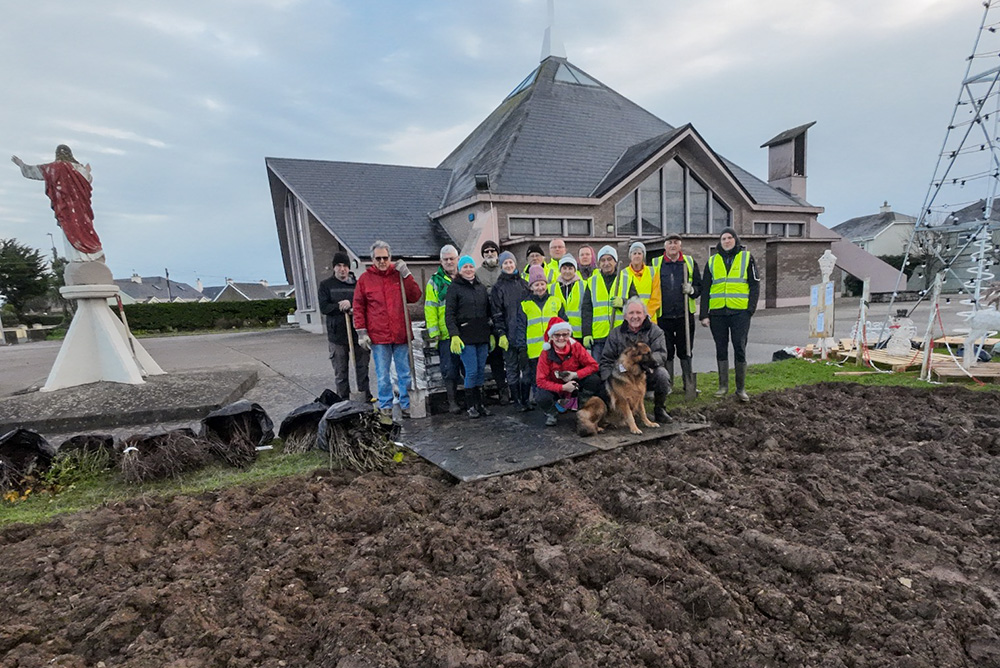
The Church of St. Patrick in Rosslare Harbour, County Wexford, Ireland, where 2,000 native trees were planted in the grass areas beside the church (Courtesy of 100 Million Trees Project)
The Mulcahys also hope that corporations and significant environmental polluters like a cement company or an airline will get behind the initiative. An airline could offset passengers' air miles by agreeing to a small levy on ticket sales that would go toward funding the purchase of saplings.
"Our aim is to plant 1.3 million trees next year and if we get the money, we will have those trees planted. The target the following year is five million. Corporates have to get serious about the environmental crisis. They need to get their checkbooks out and write the check and we'll plant the trees for them," said David Mulcahy.
Aside from this challenge of bringing new backers on board, the Mulcahys are pleased that evidence so far indicates that the Miyawaki methodology is working, and that this project may well lead to substantial change.
"Ireland is so impoverished in relation to native trees that the mere fact that we have planted over 200,000 so far this year has to make an impact," said David Mulcahy. "We would hope that 90% of the trees would survive. I think what will happen is that in 100 years the oaks and soft pines will form the upper canopy and then there will be all the alders, rowans, the Irish cherries and all the buds and berries, creating a beautiful ground for flora and fauna."
[Editor's note: This story has been updated to correct the spelling of Abbot Primate Gregory Polan's name.]









